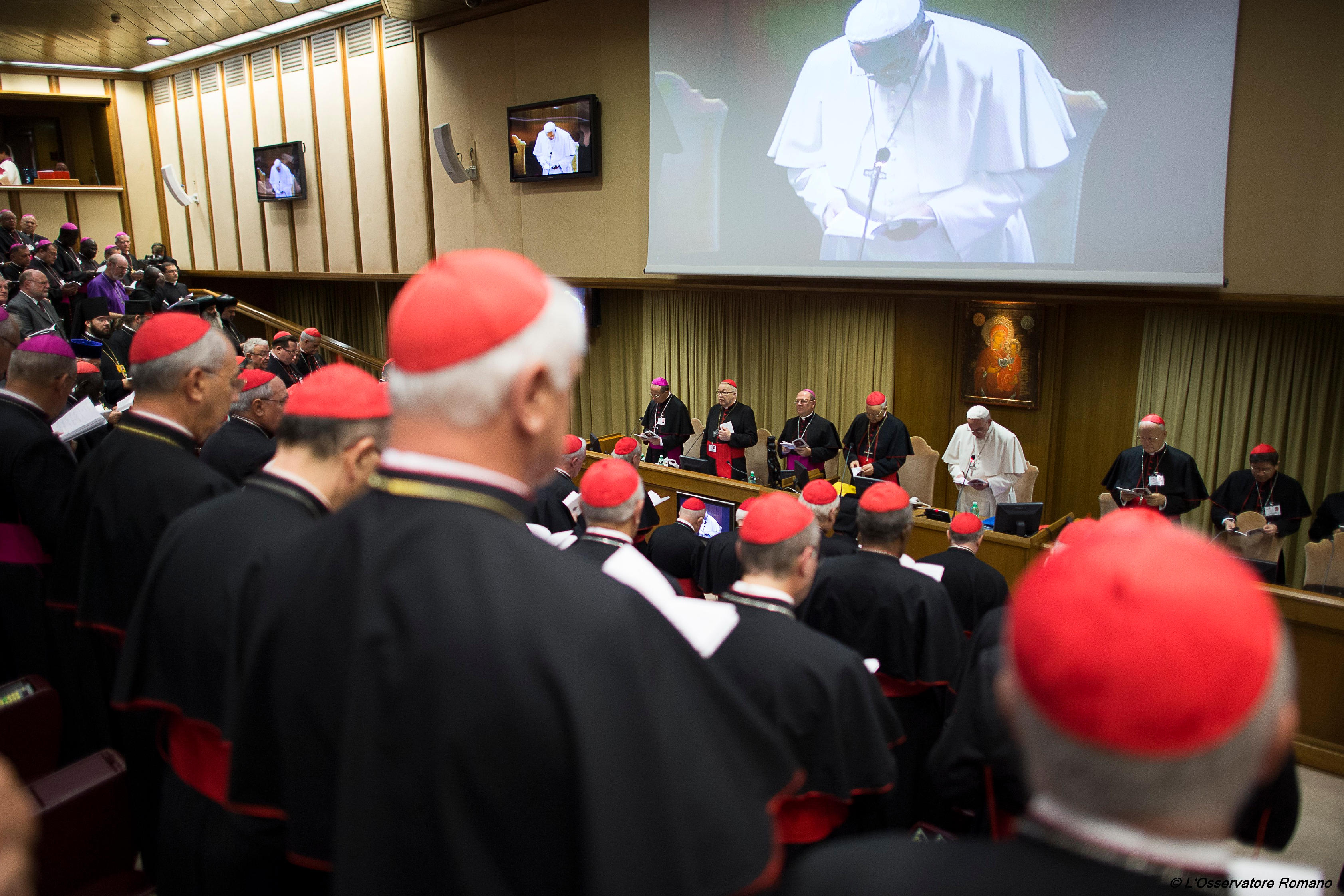Here is a ZENIT translation of the small group reports from the Italian-language group «A.» The reports were released last Friday. The small circles are divided by language and this report summarizes their discussions on the first part of the Instrumentum Laboris.
* * *
Report of Italian Circle “A”
Moderator: Cardinal Francesco Montenegro
Relator: Revd. Father Manuel Jesus Arroba Conde, C.M.F.
The Italian Circle A is made up of Fathers from different countries of Europe (East and West), two from Latin America and one from Africa. Intervening together with the fraternal delegates, were two married couples that enriched the dialogue, one in the capacity of experts, the other of auditors.
The thematic unity between this and the preceding Synodal Assembly is especially the methodological novelty regarding the procedure, with the enhanced valuation of the discussion in the Minor Circles. This caused understandable difficulty at the beginning, progressively overcome, when the reflection focused on the contents of the texts.
Also respect for the essential methodology that seems to have guided the drafting of the Instrumentum Laboris. Initial objections were not lacking, expressions of different and legitimate sensibilities between the Fathers. The obstacle that such a situation could represent was equally overcome by the desire, soon made explicit, to make an effort to offer as much as possible a testimony of unity on the contents of this part, hoping that the proposals that emerged from one and the other sensibility should appear more complementary than opposed. Added to this desire to witness unity in the discernment of the members of the Circle, in this case, the witness of unity with the Synodal path followed in the Extraordinary Assembly of last year, and to which the Holy Father solicited us explicitly. Because this path is expressed in the numbers of the Instrumentum Laboris, which take up the preceding Relatio Synodi, the proposals formulated in relation to them were characterized by the desire to enrich and complement them, but also to avoid as much as possible the introduction of changes with contents of an opposite nature.
An important benefit to the unitary reflection was derived from the desire to manifest the will to fulfil it in the wake of the unity cum Petro et sub Petro, which induced us to make use in the main of contributions to the text, from the homilies of Pope Francis, from his catecheses on the Family in the General Audiences, and from other texts of his Magisterium. A choice that is in continuity with the perennial Doctrine of the Church, of which it seemed important to mention also in this part, especially of the texts of Gaudium et Spes, making use of the observance of the 50th anniversary of the Council. It is worthwhile to stress that, the essential unity between the concerns proper to each of the two methodological sensibilities, in regard to the discernment that had to be made on the numbers of this first part, was facilitated by the perception, soon shared, of three types of needs of general importance: The need to maintain the style of approach to the challenges that the family reality represents in the present context, beginning always from positive data, affirming the hope that moves us, as well as the Lord’s presence, reassuring us also in this hour, without ignoring or playing down the gravity of the negative elements.
The need to make express mention of the radical importance that some of the negative factors have in regard to the essence itself of the family reality.
The effort to formulate the Gospel of the Family, which fecunds the various cultures, in terms of a proposal, also cultural, which is offered to all. Such an effort seems indispensable at a moment in which an epochal change is taking place (on the subject).
The Fathers of the Circle made a very serious effort to engage in discernment capable of producing the most shared formulations possible. Proof of this is the fact that the greater part of ways, after long discussions in certain cases, was voted unanimously. Indicated now synthetically are the more specific aspects that were the object of special discernment in the Circle, on the Introduction and on each of the four chapters of the first part.
Introduction
In analyzing the text of the Introduction of the document, a good number of the Fathers pointed out the need to use formulas that leave no doubt from the beginning that the only family model that corresponds to the Doctrine of the Church is that founded on marriage between man and woman. The indication was promptly received, making use of Pope Francis’ homily in the opening Mass of this Assembly.
The Introduction seemed to be the adequate place in which to refer to the epochal importance of the change underway regarding the family, and to the response also with cultural valence to which we feel called as Church.
Chapter I
On the anthropological and cultural context, it seemed necessary to refer with great abundance to the risks of the gender ideology, as well as to its negative incidence in the educational programs of many countries.
Also in regard to the challenge of secularism, it seemed necessary that there be greater development.
Chapter II
The texts on the socio-economic context were considered essentially appropriate and complete, the contributions being reduced to the express mention of the challenge that the children of separated parents represent, and to the disposable culture linked to the ecological challenge.
Chapter III
In addition to completing some situations worthy of mention in chapter III (such as the traffic of persons, the pastoral care of families that live migrations …) it seemed important to divide some inhomogeneous topics in n. 28, separating the subjects of children and women, as well as including the topic of the presence-absence of parents.
Chapter IV
In affective formation, it was felt obligatory to make express mention of the ideal of chastity and of the value of oblation.
[Original text: Italian] [Translation by ZENIT]


